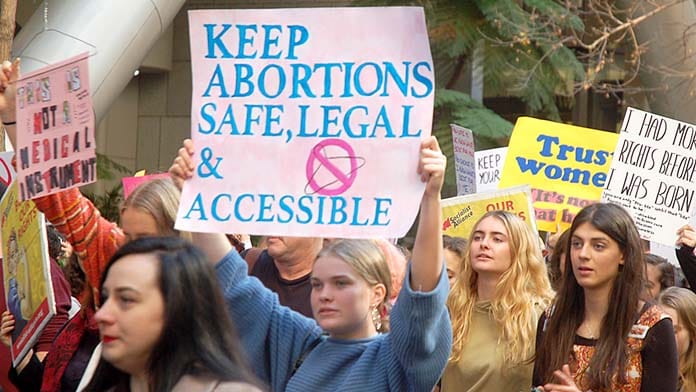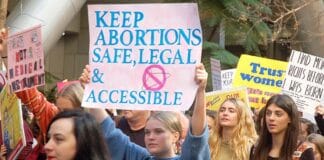Hundreds of pro-choice activists marched through Brisbane on 1 November to “keep abortion legal” in the aftermath of the Liberal National Party’s win in the Queensland election.
During the campaign anti-abortionist MP Robbie Katter (Katter’s Australian Party) promised to introduce a bill to recriminalise abortion, supported by some anti-abortion LNP politicians. LNP leader David Crisafulli refused to rule out a conscience vote for LNP MPs, creating a danger the bill might pass.
All but three LNP MPs voted against legalising abortion in 2018, including Crisafulli and his deputy Jarrod Bleijie.
The issue damaged the LNP vote. Labor campaigned strongly in the city in favour of reproductive rights, lifting their vote there from what was tipped to be a wipe-out.
This shows why Federal Liberal leader Peter Dutton wants to keep abortion off the agenda in the lead up to the federal election due by May.
The “right to choose” is a popular demand and abortion has been decriminalised in every jurisdiction across Australia.
While they are unlikely to completely overturn legislation, anti-abortionists inside and outside the Liberal Party continue to focus on later periods of pregnancy and administrative loopholes to limit access to surgery and medication.
On 16 October, an anti-abortion bill was narrowly defeated in the South Australian upper house in a conscience vote, 9-10.
Liberal MP Ben Hood’s hideous bill would have meant that women seeking abortions at about 28 weeks would be forced to give birth instead. The only choice would be whether to keep the child or have it adopted.
Greens MP Tammy Franks said that the proposal would force birth upon pregnant people seeking an abortion, including, “Children, victims of rape, incest and sexual slavery; or on much wanted pregnancies where the mother or the foetus will not survive his forced-birth plans for them.”
The anti-abortionists claim they are not aiming to ban abortion. However, their legislation would effectively ban any abortion after 27 weeks, forcing a dangerous induced early birth instead.
Specialist obstetrician and gynaecologist Dr Heather Waterfall said that compelling women to undergo premature birthing came with risks, explaining that at, “Less than 32 weeks [foetuses definitely] have an increased risk of cerebral palsy, ongoing lifelong respiratory or breathing issues.”
Hood and Katter thanked the militant anti-abortion activist and Adelaide University academic Joanna Howe for her work on the legislation strategy. Howe wants “an Australia where abortion is unthinkable”.
Federal election
Federal Liberal Party leaders have tried to slap down anyone who raises the issue.
When NT Liberal Senator Jacinta Nampijinpa Price raised her opposition to “late term abortions” she was defended by National Party Senator Barnaby Joyce but Nationals’ leader David Littleproud said he supported a “woman’s right to choose”.
Abortion is undoubtedly an issue for the Federal government, which funds Medicare rebates for abortion and provides health funding to the states and territories.
In the Senate, a lapsed “born alive” 2021 bill was reintroduced in 2022 by Liberals Alex Antic and Matt Canavan.
In August this year United Australia Party Senator Ralph Babet moved a motion charging that “at least one baby is born alive every seven days following a failed abortion and left to die”, which was factually incorrect, but supported by Coalition Senators Michaelia Cash, Sarah Henderson, Bridget McKenzie, Jacinta Nampijinpa Price and Hollie Hughes.
Queensland Labor’s campaign for abortion rights dented Katter’s bigotry.
Yet, we cannot rely on Labor to consistently defend reproductive rights. Before the 2019 federal election the Labor Party promised that, if elected, it would use federal funding to provide abortion services at all public hospitals. That policy was dumped in 2022.
Now The Greens are calling on Labor to return to their earlier policy and fund public hospitals, “To ensure that all Australians … can access essential reproductive healthcare at no cost, through the public hospital system.”
But Labor doesn’t want abortion to be on the federal election agenda either. It refuses to stand up to the conservative religious groups and anti-abortion activists opposing wider access.
Postcode lottery
Most pregnant people who require reproductive health services can access them, if you have sufficient cash. Out-of-pocket costs for a surgical abortion can be around $1000.
But abortion access remains dependent on your postcode.
Firstly, the nature of services provided in clinics and hospitals varies.
Recently, the ABC reported accusations that Queanbeyan and Orange regional hospitals denied abortion services and procedures to patients. In response, the NSW government intervened and these hospitals reversed their policies.
Lack of access in regional areas forces many people to travel to services in metropolitan areas.
As Greens Senator Larissa Waters points out: “With the closure of many private abortion facilities in recent years, many … are left with little choice but to travel hundreds of kilometres and spend thousands of dollars.”
The cost of procedures and the availability of doctors is taking its toll, especially where public hospitals are administered by the Catholic Church like the Mercy and St Vincent’s Hospitals and refuse abortion care, as they do in Victoria.
The recent Realising access report revealed the lack of services in regional Victoria, with two-thirds of local government areas in the state without a surgical abortion provider.
Queensland and Victorian governments allow midwives to conduct procedures for medication abortions (up to nine weeks gestation), improving services in those states.
Secondly, the law in each state and territory treats abortion access differently. While a first trimester abortion cannot be legally denied in any state or territory; at later stages of pregnancy, the rules vary.
In South Australia abortion can be performed at the request of a woman up to 22 weeks and six days; other states are similar, but in Tasmania it is only 16 weeks. Terminations after that point require the approval of two doctors and the pregnancy must pose significant risk of injury or to the mental health of the pregnant person, or carry significant risk of serious foetal anomalies.
In any jurisdiction, only a handful of abortions are conducted after 22 weeks. SA Health data shows that in 2023, fewer than 1 per cent of terminations (47) were performed after that stage and fewer than five terminations were performed after 27 weeks.
The ACT shows a better legal framework is possible—abortion is regulated like other medical procedures throughout the pregnancy; without doctors being the gatekeepers for abortion later in pregnancy. Abortions are free of charge up to 16 weeks’ gestation.
Internationally there has been a trend toward abortion law liberalisation on the back of mass struggles; about 60 countries now enjoy legal safe access at least to early abortions (in the first 12 weeks). Australia, too, has decriminalised abortion law after nearly six decades of struggle.
But the bigots won’t give up. The continued anti-abortion campaign waged by groups like the Australian Christian Lobby reinforces uncertainty and increases the stigma about abortion.
There is still an ongoing fight to end problems of access and unnecessary out-of-pocket costs—including against conservative Labor governments.
By Judy McVey






